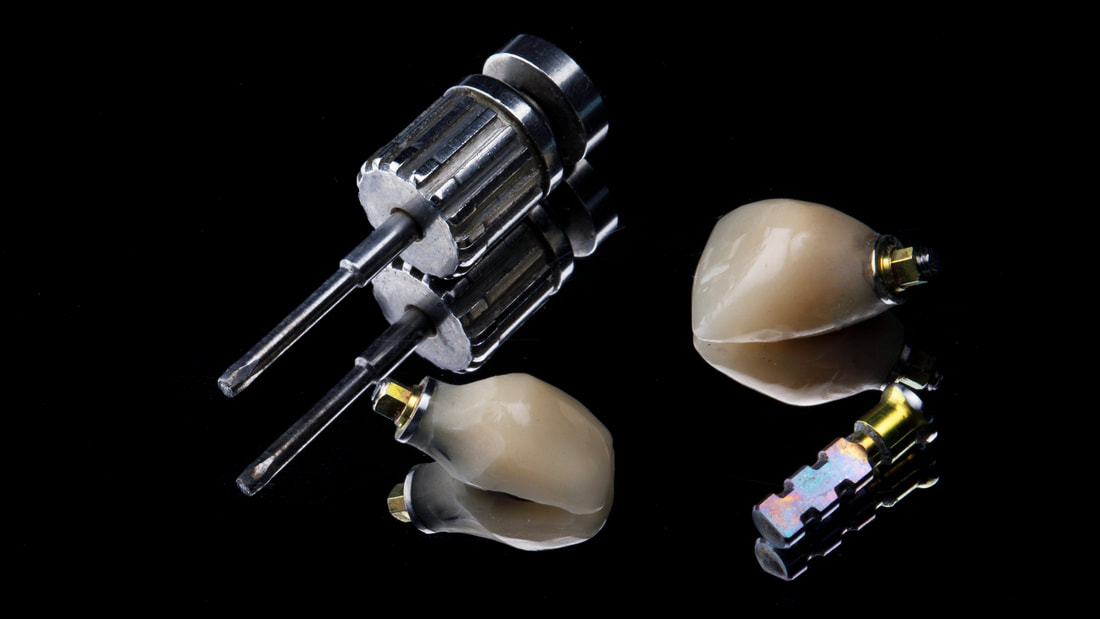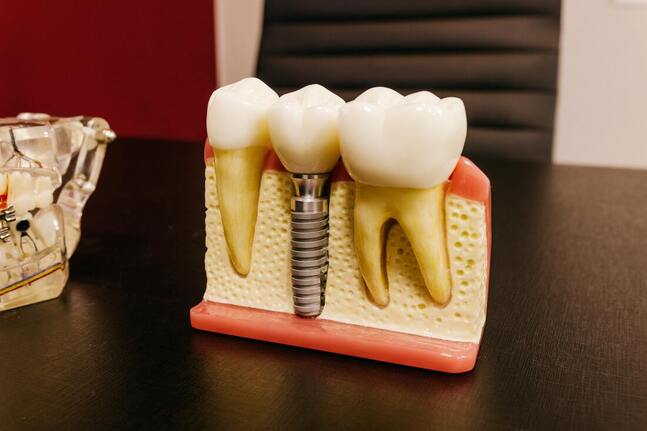|
Dental implants are small posts that serve to function as the root of a tooth. The three main parts of the implant system are the post that is inserted into the gums, the abutment that protrudes from the gum line, and the visible prosthesis. There are two main types of implant solutions: cement-retained and screw-retained implants. WHAT ARE CEMENTED AND SCREW-RETAINED IMPLANTS?Cement-retained dental implants feature crowns that are bonded to the implant with cement. On the other hand, screw-retained implants are physically screwed into the post through the abutment. Multiple studies have found that the complication rates of both methods are nearly identical with a 3-5% failure rate. Thus, the success rate for both is exceptionally high. The decision for which method is most effective depends on the case’s indications. Deciding factors include the implant’s location, the patient’s personal preference, and the body’s reaction to the material. Clinicians must evaluate each individual case and their indications to determine whether the best method would be cement or screws to secure the dental implant. PROS OF CEMENTED IMPLANTSUsing cement to secure dental implants is the most commonly used method of the two attachment styles. For cases where aesthetics are prioritized, cementation provides a superior appearance versus that of screw-retained implants. Cementing the prosthesis to the implant eliminates the need for an access hole, resulting in a natural-looking tooth. In addition, modern cement is practically invisible, creating a flawless outcome. Further advancement in cement manufacturing has led to the development of radiolucent cement which makes it easier to create a life-like restoration. Furthermore, cement-retained implant crowns have optimal resistance to porcelain fracture, allowing the restoration to maintain its aesthetics and structure for longer. CONS OF CEMENTED IMPLANTSCrowns that are cemented to the implant make removal and retrieval extremely difficult. Because the restoration is essentially soldered to the mouth, clinicians are severely limited if repairs or adjustments are needed. To gain access to the implant in the gums, generally, the entire crown has to be destroyed. Any future repairs over the implant’s lifetime will likely have the same fate, resulting in increased costs for every repair. However, using a water-soluble gel in the cement mixture may help to release the crown more easily. Another drawback of cement-retained implants is the risk of excess cement and the potential damage it could cost. The problem with using cement that is difficult to see is that it is easy to leave behind excess adhesive. Residual cement makes the optimum breeding ground for bacteria, increasing the risk of cement failure, osseointegration failure, gum inflammation, and infection. Failure to remove excess cement has also been linked to peri-implantitis, a disease that causes inflammation of the soft tissues and bone loss around the implant, as well as peri-implant mucositis, the inflammation of the peri-implant mucosa. PROS OF SCREW-RETAINED IMPLANTSScrew-retained implants are fastened into the implant post through the abutment. The biggest benefit of this method is its easy accessibility and retrievability. If the implant ever becomes damaged or worn, the prosthetic simply just has to be unscrewed. The flexibility of the screw-retained method allows for simplified removal to address damage or wear and tear without having to destroy and remake the restoration. The easy removability of the screw also gives the clinician direct visualization of the implant or quick access for a soft-tissue exam. Additionally, while clinical performance rates in terms of attachment failure are similar for both cement and screw-retained implants, it is found that screw-retained options have fewer biological and technical complications due to the lack of cement. The screw-based approach eliminates the worry of residual residue and colonizing bacteria. Thus, they are exempt from any potential damage or complications that occur due to improper cement cleanup. For sensitive patients and cases where aesthetics are of lower priority, clinicians are more likely to prefer screw-retained restorations. CONS OF SCREW-RETAINED IMPLANTSIn terms of aesthetics, implant restorations that utilize a screw are hindered due to the screw access hole left in the prosthetic. Even if the whole is covered with a tooth-colored filling, the restoration will still appear noticeably uneven. Aesthetic zones–particularly in anterior implants, have clear visibility of the screw. However, if the case allows, the screw access hole can be maneuvered and placed where it is not easily seen. Dr. John Flucke, DDS of Lee’s Summit, Missouri stated, “The pros of screw-retained are the ability to ‘undo’ if need be, but because the screw hole needs to be filled with composite, often esthetics are not quite as good.” Lastly, although the complications related to excess material are not a risk, screw-retained restorations due suffer from complications of their own since the material around the access hole is unsupported. The surrounding porcelain has a higher risk of fracturing from the lack of support. The screw also has a higher potential to loosen due to day-to-day use and chewing. CHOOSING SCREW VERSUS CEMENTED IMPLANT RESTORATIONSNeither method is correct or wrong when it comes to securing implants. However, it’s up to the clinician to weigh the factors of retrievability, aesthetics, location, and patient preference when it comes to choosing the best method. HOW CAN THE DENTAL LAB HELP?Our company is an advance implant dental lab. We specialize in all forms of implant restorations and keep our prices affordable for dental offices. Contact us today to get started on an implant case. View our product page for more restorative solutions. Sources: Cement Vs. Screw-Retained Implant Crowns How to choose between cement-retained or screw-retained implants What are dental implants? Keywords:
screw, implants, cementation, cemented, the dental lab, laboratory, restoration, tooth, teeth, gums, abutment, crown, dental implants, implant surgery, implant, cement-retained implants, screw-retained implants, dental lab, dental labs, cement retained implant crowns
0 Comments
Leave a Reply. |



